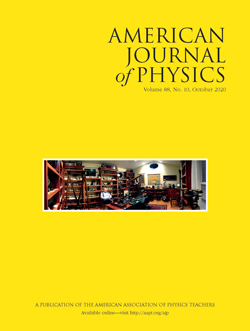 October 2020 Issue,
October 2020 Issue,
Volume 88, No. 10
Adventures with historical physics apparatus
The past is always with us, not only the physics history that we revere and try to put into our classroom presentations. Two hundred years of teaching natural philosophy (physics) have left us a significant amount of physics history in the form of early apparatus. In this article, I will tell stories about how I have become involved in the study of early physics apparatus. Because of my website on Historical Physics Teaching Apparatus, I have fielded a series of queries since the year 2000: I have inherited this apparatus, what is it and how much is it worth? My students turned up this interesting piece of apparatus and think that they might use it in an experiment—what is it and tell me how it can be put into the curriculum?
EDITORIAL
In this issue: October 2020 by Beth Parks. DOI: 10.1119/10.0001809
Editorial firsts by Beth Parks. DOI: 10.0001894
AWARDS
2020 AAPT award citations at the virtual summer meeting DOI: 10.1119/10.0001862
PAPERS
A physical model for intuiting linear regression by Phillip Cervantes, Patricia Purdue and Jeffrey Steele. DOI: 10.1119/10.0001509
A simple physical model is introduced to facilitate understanding of fitting a straight line to data. Data points are envisioned as beads applying torques on a massless, rigid, horizontal rod. The model is appropriate for beginning students, requiring only knowledge of torques and moments of inertia.
Captain Einstein: A VR experience of relativity by Karel Van Acoleyen and Jos Van Doorsselaere. DOI: 10.1119/10.0001803
A virtual reality movie lets students experience a world with a slow speed of light.
Radial velocity of a sound source in circular motion for illustrating the detection of an exoplanet by Kader Médjahdi. DOI: 10.1119/10.0001558
The detection of an exoplanet using the Doppler effect is illustrated with a Bluetooth speaker and a microphone, taking advantage of an analogy with the Doppler effect for sound. Appropriate for undergraduate courses.
Generalizing thermal resistance and a general thermal engine by Mark F. Roll. DOI: 10.1119/10.0001612
The usefulness of an engine cycle depends not only on its thermodynamic efficiency, but on its rate of heat transfer, which here is discussed in terms of a thermal resistance. Appropriate for undergraduate courses in thermal physics.
A step forward in kinesthetic activities for teaching kinematics in introductory physicsby Zachary Dale, Paul R. DeStefano, Lori Shaaban, Cora Siebert and Ralf Widenhorn. DOI: 10.1119/10.0001617
A local positioning system allows students to learn kinesthetically by acting out motions and seeing the graphs in real time
Connecting field and intensity correlations: The Siegert relation and how to test it by Dilleys Ferreira, Romain Bachelard, William Guerin, Robin Kaiser and Mathilde Fouché. DOI: 10.1119/10.0001630
An experimental setup is discussed that can be used to test the Siegert relation, which relates electric field and intensity correlations of light. Appropriate for an upper-level optics class
Lessons from transforming second-year honors physics lab by Danny Doucette, Brian D'Urso and Chandralekha Singh. DOI: 10.1119/10.0001641
Experiences are reported on a new approach to introductory physics lab with two purposes: to replace “black boxes” with interactive equipment, and to try to foster more of a “think like a physicist” attitude among students.
A perfectly inelastic collision: Bulk prey engulfment by baleen whales and dynamical implications for the world's largest cetaceans by Jean Potvin, David E. Cade, Alexander J. Werth, Robert E. Shadwick and Jeremy A. Goldbogen. DOI: 10.1119/10.0001771
The feeding behavior of whales is analyzed as a collision between the whale and krill-containing seawater, and is compared to data from whale tracking. Instructors can use the kinematic data as an example in an introductory course, and can also present this analysis in a biophysics class as an example of how basic physics affects animal behavior and evolution.
NOTES AND DISCUSSIONS
Adventures with historical physics apparatus by Thomas B. Greenslade Jr. DOI: 10.1119/10.0001685
This article presents a user's guide to identifying historical apparatus in your department's collection, as well as a brief memoire of the physicist whose work has graced the pages of AJP for almost twenty years
A simplified treatment of neutron slowing by elastic collisions by B. Cameron Reed. DOI: 10.1119/10.0001629
Neutrons in mixtures of U-235 and U-238 must be brought down to thermal energy if a chain reaction is to be sustained, and thermalization depends on the number of neutron scatterings. This number of scatterings can be calculated in an introductory course to show how basic mechanics bears on a technological issue of current importance.
Comment on “The equivalence principle in the Schwarzschild geometry” [Am. J. Phys. 62, 1037 (1994)] by Rafael P. Bernar, Luís C. B. Crispino, Atsushi Higuchi and Haroldo C. D. Lima Junior. DOI: 10.1119/10.0001572
An error in the computation of the Riemann tensor is pointed out and corrected
ADVANCED TOPICS
Visualizing topological transport by Mariya A. Lizunova, Samuel Kuypers, Bernet Meijer, Ana Silva and Jasper van Wezel. DOI: 10.1119/10.0001656
The topological constraint on edge-to-edge conductance in the quantum Hall effect is explained with a simple picture of the weakly related electronic wavefunctions at the two edges. Although the picture is intuitively appealing, the theoretical development makes this paper best suited to graduate students.
COMPUTATIONAL PHYSICS
Structure of numerical algorithms and advanced mechanics by Siu A. Chin. DOI: 10.1119/10.0001616
The nature and, in particular, the stability of numerical algorithms for differential equations are explained by showing how stable algorithms can be viewed as embodying the Liouville theorem for phase space. This paper, best suited for graduate students, helps to clarify both advanced mechanics (Hamilton's equations, Poisson brackets,…) and computational schemes.
BOOK REVIEWS
Lectures on Astrophysics by Milan M. Ćirković. DOI: 10.1119/10.0001751
A strong endorsement of a brief book on astrophysics for advanced undergraduates and graduate students.
About AJP
General Information, Resources for Authors, Reviewers, and Readers

